Basil Characteristics
(Ocymum basilicum)
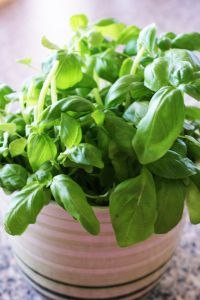
Name Origin of Basil:
Signifies royal or kingly most likely due to the plant’s use in feasts. In France it is known as herb royale and the generic name is derived from Oza – a Greek word meaning odor. Read more on the History of Basil
Natural Order:
Labiatæ
Growing Cycle:
Biennial or Perennial Herb
Origins:
Native of tropical Asia. Used for centuries in India as a condiment.
Height:
12 – 20 inches tall
Flowers:
Little white or lilac (purple basil) flowers followed by small black berries containing the seeds.
Common Basil Cultivars:
Dwarf or bush basil, sacred basil, east Indian or tree basil, purple basil, and lettuce-leaved basil. Learn more about the different kinds of basil in our article on basil varieties.
Fun Basil Fact.
During the reigns of Queen Mary and Queen Elizabeth, farmers complimented visiting landladies with the presentation of a potted basil plant.
How to Grow Basil
(Seeds, sowing, transplantation, propagation, harvesting and growing indoors)
Growing Basil From Seeds.
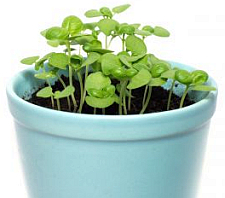
Basil seeds are viable for about 8 years and are very tiny; about 23,000 basil seeds weigh an ounce.
When growing basil from seed, your best option is sowing them in flats with a light covering of soil due to their small size. Water flats from the bottom until surface shows a wet spot. One gardening book recommended watering seedlings before their true leaves appear with a cool chamomile and nettle tea. When basil seedlings are about an inch tall, thin so that each plant is two inches apart.
Before growing basil in your herb garden, check out our Basil Companion Planting Guide to help you decide which other herbs and plants you might want to plant with basil.
Transplanting Basil
Wait until your basil seedlings are at least 3 inches tall before transplantation. Basil seedlings should have two sets of true leaves, so don’t rely entirely upon the height of your plants. Transplant basil seedlings to a sunny location in your garden but be prepared to provide some shade during the hottest part of the day to young plants. Plant a foot apart in rows separated by 15 to 18 inches. Growing basil as border plants may require a bit more tending and removal of weeds between the plants. Basil prefers light fertile and somewhat dry soil that’s as free from weeds as possible. When plants in adjoining rows meet, cultivation may stop.
Be mindful of mid-day sun as growing basil plants may find it too hot. And, avoid windy locations as the wind can burn young growth.
When to Harvest Basil Leaves
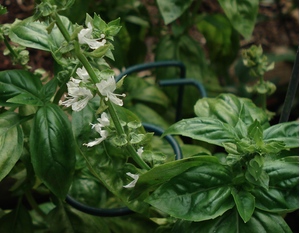 You can begin gathering foliage in midsummer when the plants start to flower (once the basil plants flower, the flavor decreases) by cutting individual basil leaves or leafy stems. It’s best to cut the larger leaves of your basil plant first. If you harvest/cut the plants back every few weeks, it will encourage new growth and delay flowering. To extend your basil growing season, cut plants down to within a few inches of the ground to get a second and even a third crop. A little bit of fertilizer after pruning is helpful.
You can begin gathering foliage in midsummer when the plants start to flower (once the basil plants flower, the flavor decreases) by cutting individual basil leaves or leafy stems. It’s best to cut the larger leaves of your basil plant first. If you harvest/cut the plants back every few weeks, it will encourage new growth and delay flowering. To extend your basil growing season, cut plants down to within a few inches of the ground to get a second and even a third crop. A little bit of fertilizer after pruning is helpful.
Basil Propagation
Allow some of the strongest plants to remain uncut. Seeds should be ripe by mid-autumn and can self-seed.
Over-Wintering or Growing Basil Indoors
Transplant from the garden or sow seeds in early September. Sow seeds two to the inch and transplant seedlings into pots or boxes. A standard 4-inch pot is the perfect size for a single plant. If grown in flats, basil plants should be spaced 5 to 6 inches apart in each direction.
Growing basil indoors requires a sunny window. It is among one of the easiest of the culinary herbs to grow on a kitchen windowsill. Unfortunately, basil grown indoors does not have as much flavor or fragrance as basil grown outside.
Culinary Uses for Basil
(leaves and oil)
Leaves
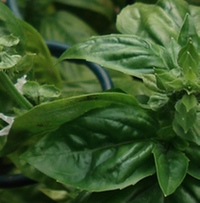 Basil leaves are used in many dishes including soups, stews, and dressings. Basil makes a great compliment for garlic and is a favorite when used as a pesto sauce. It is often used in Mediterranean cooking and in tomato dishes.
Basil leaves are used in many dishes including soups, stews, and dressings. Basil makes a great compliment for garlic and is a favorite when used as a pesto sauce. It is often used in Mediterranean cooking and in tomato dishes.
Torn leaves make a fresh and tasty addition to summer salads and a special treat on a pizza.
Don’t miss our own recipe for lime basil sorbet and popsicles. You can also find a wide variety of ways to incorporate in your recipes with The Flavor Bible, a truly taste-filled book available on Amazon.
Oil
Basil oil, a golden yellow essential oil, reddens with age and is more frequently used for perfumery than cooking.
Additional Basil Facts
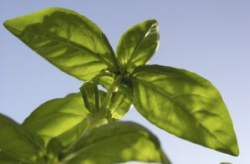
When growing basil, why not learn what other herbs and plants grow well with it and which ones don’t do as well along with what beneficial insects basil attracts from our basil companion planting guide.
There are around 33 basil species and 200 cultivars. Check out our basil varieties article for more information.
The history of basil usage dates back over 4,000 years to Ancient Egypt and is native to India. It has been associated with royalty, love and death. Once thought to be poisonous, some physicians even proclaimed basil was harmful to even smell, much less ingest. It has been associated with love potions, scorpions on the brain and misfortune. If you want learn more historical basil facts, please check out our article on the history of basil.
Where to Buy Basil Seeds
Did you know that Amazon.com offers a huge selection of seeds, including a variety of basil varieties? While you might not be able to get every known variety of basil seeds (who has that anyway), you will find a huge selection of heirloom, non-GMO and exotic varieties. Check these out…and they’re only a few of the choices.
